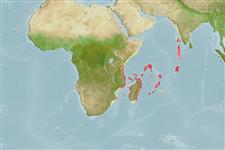Classification / Names
Noms communs | Synonymes | Catalog of Fishes(Genre, Espèce) | ITIS | CoL | WoRMS | Cloffa
>
Ophidiiformes (Cusk eels) >
Dinematichthyidae (Viviparous brotula)
Etymology: Mascarenichthys: Named in reference to the Mascarene plate, from where most of the specimens observed so far have been obtained.; heemstrai: Named for Phillip C. Heemstra, SAIAB, Grahamstown..
More on authors: Schwarzhans & Møller.
Environment: milieu / climate zone / depth range / distribution range
Écologie
marin benthopélagique; profondeur 0 - 11 m (Ref. 76869). Tropical
Western Indian Ocean: Seychelles, Cargados Carajos, Mauritius and Reunion, except Agalega Islands.
Taille / Poids / Âge
Maturity: Lm ? range ? - ? cm
Max length : 4.4 cm SL mâle / non sexé; (Ref. 76869); 5.1 cm SL (female)
Description synthétique
Morphologie | Morphométrie
Rayons mous dorsaux (Total): 62-73; Rayons mous anaux: 46 - 56; Vertèbres: 39 - 42. This species is distinguished by the following characters: D 62-73, A 46-56, pectoral fin rays 16-18, D/A 17-25, V in D 1.8-2.1; vertebrae 11+28-30 (rarely 31) = 39-41 (rarely 42); anterior nostril located 1/4-1/5 the distance from upper lip to aggregate distance to anterior margin of eye; moderately large eyes, 1.5-2.7 % SL; 2 pairs of free pseudoclaspers, outer pseudoclasper simple, flap-shaped with pointed tip, broad at base, short, slightly longer than inner pseudoclasper, the inner one is broad, with 3 ridges in anterior, posterior and inward direction and hidden in pocket of wide isthmus (in resting position); 5-7 scale rows on cheek at the upper part and 3-4 rows on lower part; presence of upper preopercular pore present; otolith very elongate, its length to height 2.3-2.5, with sulcus slightly inclined (5°) and colliculi separated, ostium length to cauda length is 3.5-4.5 (Ref. 76869).
Usually observed in catches from the back reef lagoonal and tide pool environments and rare to nearly absent from the main and outer reef environments where Dinematichthys indicus is found (Ref. 76869).
Life cycle and mating behavior
Maturité | Reproduction | Frai | Œufs | Fécondité | Larves
Schwarzhans, W. and P.R. Møller, 2007. Review of the Dinematichthyini (Teleostei: Bythitidae) of the Indo-west Pacific. Part III. Beaglichthys, Brosmolus, Monothrix and eight new genera with description of 20 new species. The Beagle, Records of the Museums and Art Galleries of the Northern Territory 23:29-110. (Ref. 76869)
Statut dans la liste rouge de l'IUCN (Ref. 130435)
Utilisations par l'homme
Plus d'informations
PaysZones FAOÉcosystèmesOccurrencesIntroductionsStocksÉcologieRégime alimentaireÉléments du régime alimentaireConsommation alimentaireRation
Noms communsSynonymesMétabolismePrédateursÉcotoxicologieReproductionMaturitéFraiRassemblement de ponteFéconditéŒufsDéveloppement de l'œuf
Taille/ÂgeCroissanceLongueur-poidsLongueur-longueurFréquences de longueursMorphométrieMorphologieLarvesDynamique des populations larvairesRecrutementAbondanceBRUVS
RéférencesAquacultureProfil d'aquacultureSouchesGénétiqueElectrophoresesHéritabilitéPathologiesTraitementNutrientsMass conversion
CollaborateursImagesStamps, Coins Misc.SonsCiguateraVitesseType de nageSurface branchialeOtolithesCerveauxVision
Outils
Articles particuliers
Télécharger en XML
Sources Internet
Estimates based on models
Preferred temperature (Ref.
123201): 25.4 - 28.9, mean 27.4 °C (based on 322 cells).
Phylogenetic diversity index (Ref.
82804): PD
50 = 0.6250 [Uniqueness, from 0.5 = low to 2.0 = high].
Bayesian length-weight: a=0.00389 (0.00180 - 0.00842), b=3.12 (2.94 - 3.30), in cm total length, based on all LWR estimates for this body shape (Ref.
93245).
Niveau trophique (Ref.
69278): 3.2 ±0.5 se; based on size and trophs of closest relatives
Fishing Vulnerability (Ref.
59153): Low vulnerability (10 of 100).
